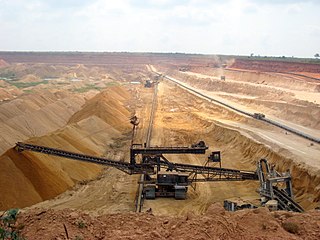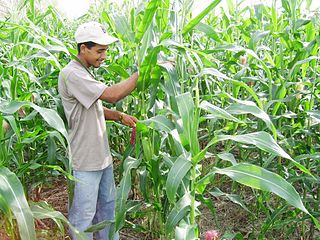
The economy of Togo has struggled greatly. The International Monetary Fund (IMF) ranks it as the tenth poorest country in the world, with development undercut by political instability, lowered commodity prices, and external debts. While industry and services play a role, the economy is dependent on subsistence agriculture, with industrialization and regional banking suffering major setbacks.

Agricultural policy describes a set of laws relating to domestic agriculture and imports of foreign agricultural products. Governments usually implement agricultural policies with the goal of achieving a specific outcome in the domestic agricultural product markets. Well designed agricultural policies use predetermined goals, objectives and pathways set by an individual or government for the purpose of achieving a specified outcome, for the benefit of the individual(s), society and the nations' economy at large. The goals could include issues such as biosecurity, food security, rural poverty reduction or increasing economic value through cash crop or improved food distribution or food processing.

An agricultural subsidy is a government incentive paid to agribusinesses, agricultural organizations and farms to supplement their income, manage the supply of agricultural commodities, and influence the cost and supply of such commodities.

A cash crop, also called profit crop, is an agricultural crop which is grown to sell for profit. It is typically purchased by parties separate from a farm. The term is used to differentiate marketed crops from staple crop in subsistence agriculture, which are those fed to the producer's own livestock or grown as food for the producer's family.
Trade barriers are government-induced restrictions on international trade. According to the theory of comparative advantage, trade barriers are detrimental to the world economy and decrease overall economic efficiency.
Trade can be a key factor in economic development. The prudent use of trade can boost a country's development and create absolute gains for the trading partners involved. Trade has been touted as an important tool in the path to development by prominent economists. However trade may not be a panacea for development as important questions surrounding how free trade really is and the harm trade can cause domestic infant industries to come into play.
The Caribbean Basin Initiative (CBI), a trade initiative initiated by the 1983 Caribbean Basin Economic Recovery Act (CBERA), is a United States program. The CBI came into effect on January 1, 1984, and aimed to provide several tariff and trade benefits to many Central American and Caribbean countries. Provisions in the CBERA prevented the United States from extending preferences to CBI countries that it judged to be contrary to its interests or that had expropriated American property.

Malawi is one of the world's undeveloped countries and is ranked 170 out of 187 countries according to the 2010 Human Development Index. It has about 16 million people, 53% of whom live under the national poverty line and 90% of whom live on less than $2 per day.
The Agreement on Agriculture (AoA) is an international treaty of the World Trade Organization. It was negotiated during the Uruguay Round of the General Agreement on Tariffs and Trade, and entered into force with the establishment of the WTO on 1 January 1995.
The grain trade refers to the local and international trade in cereals such as wheat, barley, maize, and rice, and other food grains. Grain is an important trade item because it is easily stored and transported with limited spoilage, unlike other agricultural products. Healthy grain supply and trade is important to many societies, providing a caloric base for most food systems as well as important role in animal feed for animal agriculture.

Agriculture in South Korea is a sector of the economy of South Korea. Korean agriculture is the basic industry of the Korean economy, consisting of farming, animal husbandry, forestry and fishing. At the time of its founding, Korea was a typical agricultural country, with more than 80% of the population engaged in agricultural production. After land reform under the Lee Seung-man administration, economic revitalization under the Park Chung-hee military government and the wave of world trade liberalization that began in the 1980s, Korean agriculture has undergone dramatic changes. Through the Green Revolution, Korea became self-sufficient in rice, the staple food, in 1978, and in 1996, Korea became the first Asian country after Japan to mechanize its agriculture with fine-grained cultivation. The development of Korean agriculture has also led to the development of agriculture-related industries such as fertilizer, agricultural machinery and seed.
Tariffication is an effort to convert all existing agricultural non-tariff barriers to trade (NTBs) into bound tariffs and to reduce these tariffs over time. A bound tariff is one which has a "ceiling" beyond which it cannot be increased.

Agriculture in Haiti describes the tortured agricultural history of an island nation once described as the "Pearl of the Antilles". The Taíno people were the farming inhabitants of the island when the Spanish first visited in the late 15th century. The Taino died out from European diseases and exploitation and were replaced with imported African slaves. In the 18th century, Haiti became a country of large plantations, especially of sugar cane, owned by Europeans and worked by hundreds of thousands of slaves. The slaves revolted in 1791 and gained independence from France. The plantations were broken up and the land was distributed to former slaves who primarily engaged in subsistence agriculture with coffee as their most important cash crop and as Haiti's most important export.

Agriculture employs the majority of Madagascar's population. Mainly involving smallholders, agriculture has seen different levels of state organisation, shifting from state control to a liberalized sector.

World food prices increased dramatically in 2007 and the first and second quarter of 2008, creating a global crisis and causing political and economic instability and social unrest in both poor and developed nations. Although the media spotlight focused on the riots that ensued in the face of high prices, the ongoing crisis of food insecurity had been years in the making. Systemic causes for the worldwide increases in food prices continue to be the subject of debate. After peaking in the second quarter of 2008, prices fell dramatically during the late-2000s recession but increased during late 2009 and 2010, reaching new heights in 2011 and 2012 at a level slightly higher than the level reached in 2008. Over the next years, prices fell, reaching a low in March 2016 with the deflated Food and Agriculture Organization (FAO) food price index close to pre-crisis level of 2006.

Rice production in Japan is important to the food supply in Japan, with rice being a staple part of the Japanese diet. Most people in Japan see this food as a substantial part of their daily diet.

Agriculture in Panama is an important sector of the Panamanian economy. Major agricultural products include bananas, cocoa beans, coffee, coconuts, timber, beef, chicken, shrimp, corn, potatoes, rice, soybeans, and sugar cane.
Opinions about the role of fertilizer subsidies in spurring agricultural development in Sub-Saharan Africa have fluctuated significantly over the past five decades. Many experts believe that fertilizer subsidies represent an essential method for achieving long term food security in Sub-Saharan Africa, while providing social support to Africa's poorest subsistence farmers. Yet previous universal subsidy schemes enjoyed only moderate success, raising concerns about whether the market distortions subsidies introduce can ever lead to a sustainable agricultural system. New practices in creating more targeted subsidies may be the key to achieving durable success.
In feminist economics, the feminization of agriculture refers to the measurable increase of women's participation in the agricultural sector, particularly in the developing world. The phenomenon started during the 1960s with increasing shares over time. In the 1990s, during liberalization, the phenomenon became more pronounced and negative effects appeared in the rural female population. Afterwards, agricultural markets became gendered institutions, affecting men and women differently. In 2009 World Bank, FAO & IFAD found that over 80 per cent of rural smallholder farmers worldwide were women, this was caused by men migrating to find work in other sectors. Out of all the women in the labor sector, the UN found 45-80% of them to be working in agriculture
Agriculture makes up a significant proportion of the Gambia's economy, comprising 25% of its GDP. About 75% of workers in the Gambia are employed within the agricultural industry. The main cash crops produced in the country are groundnuts, millet, sorghum, mangoes, corn, sesame, palm kernel, and cashews. The main staple crop produced is rice.










